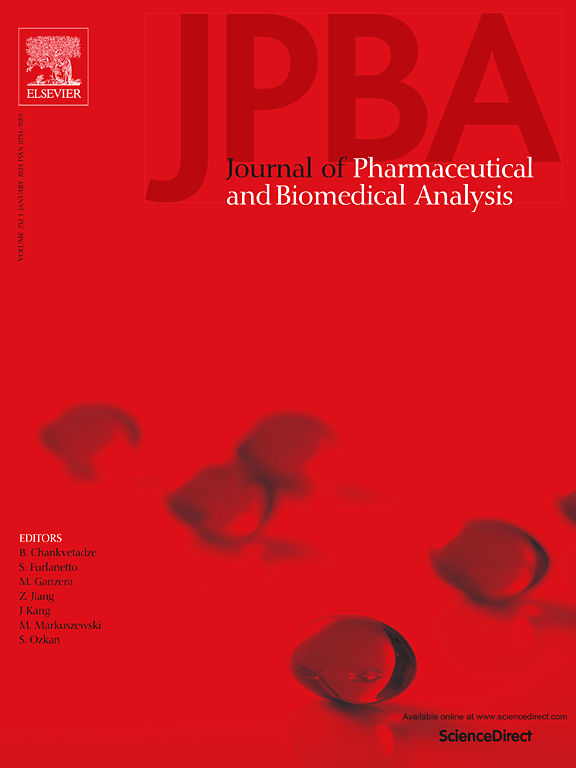利用双环糊精毛细管电泳系统分离托哌酮及其降解产物,研究它们在过敏事件中的潜在作用。
IF 3.1
3区 医学
Q2 CHEMISTRY, ANALYTICAL
Journal of pharmaceutical and biomedical analysis
Pub Date : 2024-10-17
DOI:10.1016/j.jpba.2024.116532
引用次数: 0
摘要
托哌酮是一种中枢作用的肌肉松弛剂,曾用于治疗中风后痉挛和腰背痛。最近,由于对过敏性不良事件的担忧与日俱增,人们对托哌酮药品的安全性进行了重新评估。托哌酮的反应性降解物可能是导致这些过敏反应的原因。通过与蛋白质形成加合物,它们可能成为诱发过敏反应的过敏原。本研究的目的是检测托哌酮药品中是否存在这些降解物,并评估它们的反应性,以阐明它们在托哌酮促过敏效应中可能扮演的角色。为此,开发并验证了毛细管电泳紫外检测法(CE-UV)来定量检测降解剂。应用双环糊精系统实现了适当的迁移顺序,从而能够在高浓度的托哌酮存在下分析2-甲基-1-(4-甲基苯基)丙-2-烯-1-酮(MMP)和1-(4-甲基苯基)丙-1-酮(MMPO)。在活性药物成分的强制降解试验中,MMP 被确定为主要降解剂。不同制造商生产的托哌酮产品中的 MMP 含量也存在差异,这突出表明了配方对其稳定性的影响。由于发现 MMP 与半胱氨酸形成快速且几乎完全的加合物,因此证明了 MMP 的高反应性。因此,这种降解剂可能是导致托哌酮产生过敏性不良反应的原因,即使它在片剂中的含量很微量,也很容易在体内与蛋白质发生反应。本文章由计算机程序翻译,如有差异,请以英文原文为准。
Separation of tolperisone and its degradation products by a dual cyclodextrin capillary electrophoresis system to study their potential role in allergic events
Tolperisone is a centrally acting muscle relaxant that has been used for the treatment of post-stroke spasticity and low back pain. Recently, the safety of tolperisone pharmaceutical products has been reassessed due to growing concerns over allergic adverse events. Reactive degradants of tolperisone may be responsible for these hypersensitivity reactions. By forming adducts with proteins, they may act as haptens that could evoke allergic reactions. The objective of this study was to examine the presence of these degradants in tolperisone pharmaceutical products and to assess their reactivity to elucidate their possible role in the pro-allergic effect of tolperisone. For this purpose, capillary electrophoresis UV detection (CE-UV) method was developed and validated for the quantification of degradants. A dual cyclodextrin system was applied to achieve the appropriate migration order enabling the analysis of 2-methyl-1-(4-methylphenyl)prop-2-en-1-one (MMP) and 1-(4-methylphenyl)propan-1-one (MMPO) in the presence of high concentrations of tolperisone. MMP was identified as the main degradant in forced degradation tests of the active pharmaceutical ingredient. Differences in MMP content of tolperisone products by different manufacturers have also been found, highlighting the role of formulation in their stability. High reactivity of MMP was demonstrated as rapid and almost complete adduct formation with cysteine was found. This degradant thus might be responsible for the allergic adverse effects of tolperisone even when it is present in trace amounts in tablets by readily reacting with proteins in vivo.
求助全文
通过发布文献求助,成功后即可免费获取论文全文。
去求助
来源期刊
CiteScore
6.70
自引率
5.90%
发文量
588
审稿时长
37 days
期刊介绍:
This journal is an international medium directed towards the needs of academic, clinical, government and industrial analysis by publishing original research reports and critical reviews on pharmaceutical and biomedical analysis. It covers the interdisciplinary aspects of analysis in the pharmaceutical, biomedical and clinical sciences, including developments in analytical methodology, instrumentation, computation and interpretation. Submissions on novel applications focusing on drug purity and stability studies, pharmacokinetics, therapeutic monitoring, metabolic profiling; drug-related aspects of analytical biochemistry and forensic toxicology; quality assurance in the pharmaceutical industry are also welcome.
Studies from areas of well established and poorly selective methods, such as UV-VIS spectrophotometry (including derivative and multi-wavelength measurements), basic electroanalytical (potentiometric, polarographic and voltammetric) methods, fluorimetry, flow-injection analysis, etc. are accepted for publication in exceptional cases only, if a unique and substantial advantage over presently known systems is demonstrated. The same applies to the assay of simple drug formulations by any kind of methods and the determination of drugs in biological samples based merely on spiked samples. Drug purity/stability studies should contain information on the structure elucidation of the impurities/degradants.

 求助内容:
求助内容: 应助结果提醒方式:
应助结果提醒方式:


